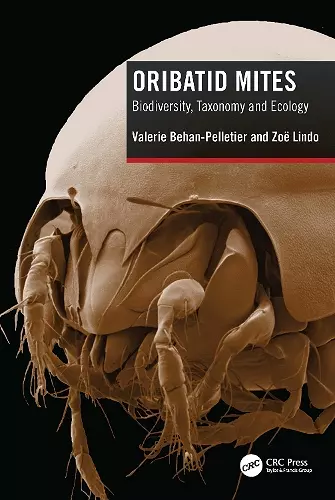Oribatid Mites
Biodiversity, Taxonomy and Ecology
Valerie Behan-Pelletier author Zoë Lindo author
Format:Hardback
Publisher:Taylor & Francis Ltd
Published:31st Jan '23
Currently unavailable, and unfortunately no date known when it will be back

This book offers a comprehensive identification guide for oribatid mites, detailing species, families, and their ecological significance in the Northern Hemisphere.
Oribatid mites, commonly referred to as beetle or moss mites, comprise over 10,000 named species across 172 families globally. This comprehensive guide, Oribatid Mites, presents a detailed identification key for 96 families, 250 genera, and approximately 580 described species found in Canada and Alaska. This collection represents more than half of the genera in the Northern Hemisphere, making it a critical resource for researchers and enthusiasts alike.
In addition to identification, Oribatid Mites delves into the ecological data of these species, their distribution throughout the Holarctic region, and relevant literature. The book emphasizes the ecological significance of oribatid mites, which serve as model organisms in studies related to development, morphology, ecology, physiology, and biomechanics. The growing awareness of soil systems' importance for agriculture, reclamation, carbon storage, and climate mitigation has spurred interest in the diverse soil biodiversity these mites contribute to.
The authors, two prominent experts in the field, aim to enhance understanding and appreciation of oribatid mites as part of the charismatic microfauna. With its extensive information and captivating imagery, Oribatid Mites is an unparalleled resource that hopes to inspire readers to recognize the unique beauty and ecological importance of these often-overlooked creatures.
It is said that each step one takes in any natural habitat is being supported by thousands of tiny legs of soil-dwelling arthropods. A major portion of these belong to oribatid mites, yet North American biologists never have had a resource that could take them from zero knowledge to species identification. Now they do – but this book is far more than an identification guide to an underappreciated group of diverse and fascinating animals. The experienced and knowledgeable authors introduce well-referenced topics that show how oribatid mites can help us address a vast range of biological, ecological and biogeographical questions.
--Roy A. Norton, Emeritus Professor and acarologist, State University of New York, College of Environmental Science and Forestry, USA
This book is an amazing work – impeccably arranged, both methodologically and in terms of content. It supplies a highly reliable and interesting collection of data on the taxonomy, ecology and geographic distribution of oribatid mites in all ecosystems of Canadian and Alaskan landscapes. The authors present an original interpretation of the high diversity, ecological importance, and natural causes of occurrence of these mites across many different ecosystems throughout the world. This book is unrivalled in the worldwide scientific literature in its field, and it will certainly meet with major interest, both in and outside Canada.
-- Wojciech Niedbała, Emeritus Professor, Department of Animal Taxonomy and Ecology, Adam Mickiewicz University, Poland
This is a book I wish I had had available when I started working on oribatid mites. It is unique in providing a comprehensive compendium of all aspects of acarine biology, making it an ideal introduction that will serve as a treasured reference book for a long time, fostering a holistic understanding of these fascinating, but often understudied organisms. Bringing all these informations on form, function, phylogeny and distribution together in one comprehensible and concise collection will no doubt incite the widened interest and collaborative research the oribatida deserve. Many thanks to all authors for undertaking the effort to provide us with this invaluable resource.
-- Paavo Bergmann, Department of Biology, Konstanz University, Germany
It is said that each step one takes in any natural habitat is being supported by thousands of tiny legs of soil-dwelling arthropods. A major portion of these belong to oribatid mites, yet North American biologists never have had a resource that could take them from zero knowledge to species identification. Now they do – but this book is far more than an identification guide to an underappreciated group of diverse and fascinating animals. The experienced and knowledgeable authors introduce well-referenced topics that show how oribatid mites can help us address a vast range of biological, ecological and biogeographical questions.
--Roy A. Norton, Emeritus Professor and acarologist, State University of New York, College of Environmental Science and Forestry, USA
This book is an amazing work – impeccably arranged, both methodologically and in terms of content. It supplies a highly reliable and interesting collection of data on the taxonomy, ecology and geographic distribution of oribatid mites in all ecosystems of Canadian and Alaskan landscapes. The authors present an original interpretation of the high diversity, ecological importance, and natural causes of occurrence of these mites across many different ecosystems throughout the world. This book is unrivalled in the worldwide scientific literature in its field, and it will certainly meet with major interest, both in and outside Canada.
-- Wojciech Niedbała, Emeritus Professor, Department of Animal Taxonomy and Ecology, Adam Mickiewicz University, Poland
This is a book I wish I had had available when I started working on oribatid mites. It is unique in providing a comprehensive compendium of all aspects of acarine biology, making it an ideal introduction that will serve as a treasured reference book for a long time, fostering a holistic understanding of these fascinating, but often understudied organisms. Bringing all these informations on form, function, phylogeny and distribution together in one comprehensible and concise collection will no doubt incite the widened interest and collaborative research the oribatida deserve. Many thanks to all authors for undertaking the effort to provide us with this invaluable resource.
-- Paavo Bergmann, Department of Biology, Konstanz University, Germany
ISBN: 9781032102931
Dimensions: unknown
Weight: 1260g
508 pages